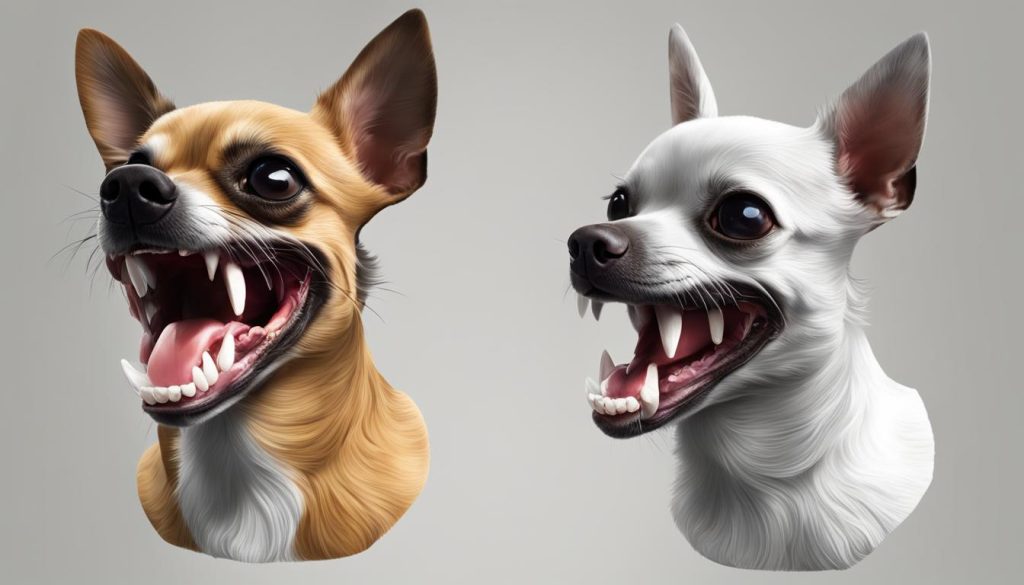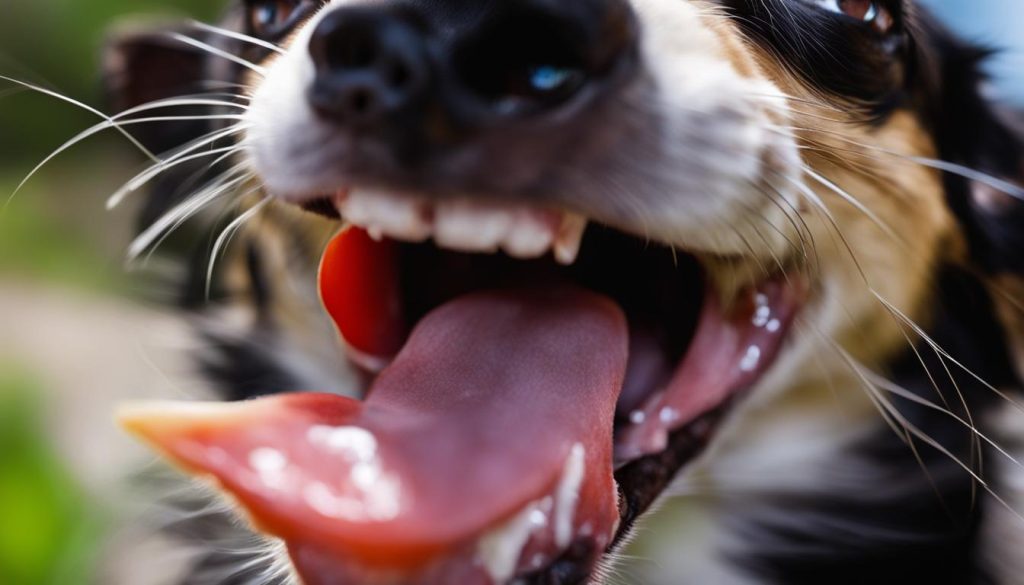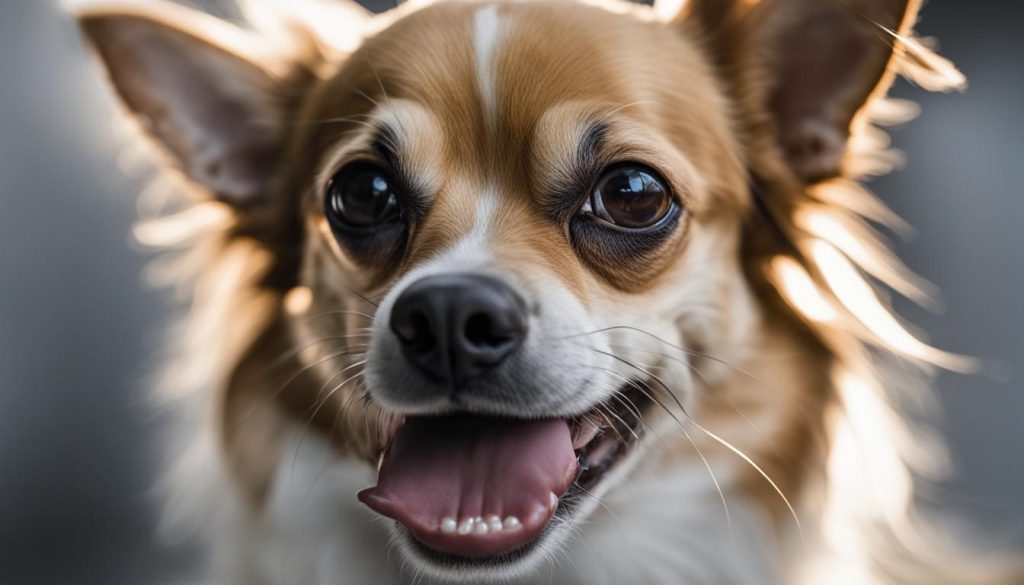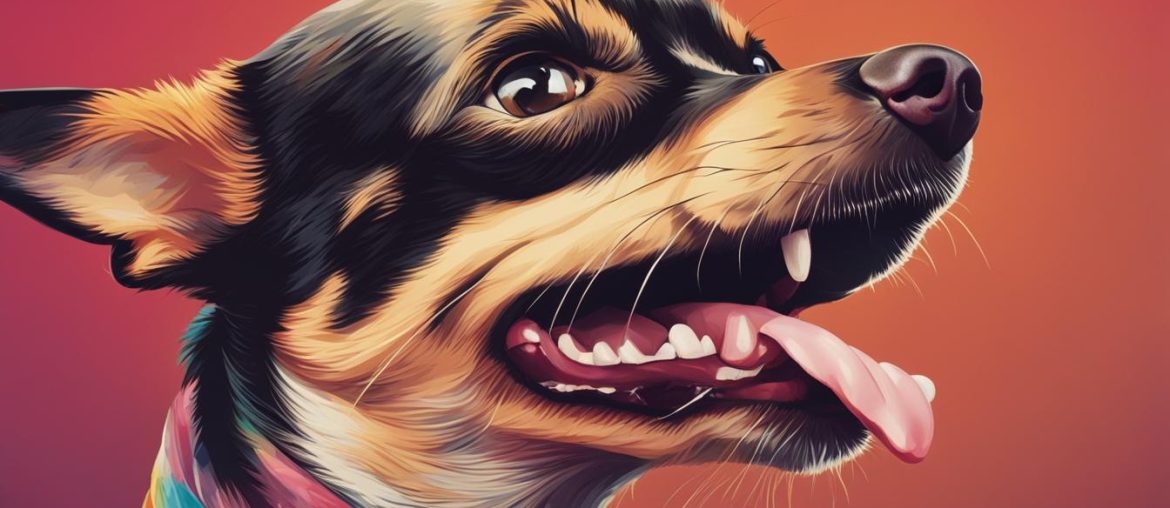Welcome to my article on chihuahua dental health. As a professional copywriting journalist, I’m here to provide you with all the essential information you need to know about your chihuahua’s teeth. One common question that chihuahua owners often ask is, “How many teeth do chihuahuas have?”
Chihuahuas, like all dogs, go through various stages of dental development. From their cute puppy teeth to their full set of adult teeth, understanding the dental anatomy and care for your chihuahua is crucial in maintaining their overall health and wellbeing.
Key Takeaways:
- Chihuahuas have 42 permanent teeth in adulthood, with 20 in the upper jaw and 22 in the lower jaw.
- Puppies start getting their puppy teeth at 3 to 4 weeks old and should have all 28 puppy teeth by 3-5 months of age.
- The four types of dog teeth include incisors, canines, premolars, and molars, each serving its own purpose in chewing and eating.
- Tooth loss in adult chihuahuas may be a sign of periodontal disease or tooth decay, emphasizing the importance of proper dental care.
- Regular dental care, including brushing and veterinary dental cleanings, is essential to prevent tooth loss and maintain chihuahua dental health.
Puppy Teeth Development

When it comes to chihuahua puppies, their dental journey begins without any teeth. However, at around 3 to 4 weeks old, their puppy teeth, also known as deciduous teeth or milk teeth, start to emerge. By the time they reach 3-5 months of age, chihuahua puppies should have all 28 puppy teeth fully developed, including incisors, canines, and premolars. These tiny teeth play a vital role in the initial stages of their chewing and eating process.
Here is a breakdown of the types of puppy teeth a chihuahua should have:
- Incisors: These small teeth are located at the front of the mouth and are responsible for scraping and nibbling food.
- Canines: Also known as “fangs,” canines are long and pointed teeth situated behind the incisors. They help chihuahua puppies tear and grip their food.
- Premolars: The pre-molars are wider teeth found on the sides of the jaw. These teeth assist in shredding and chewing food.
It’s important to note that these puppy teeth are temporary and will eventually fall out to make way for the chihuahua’s adult teeth. This transition typically occurs between 10-12 weeks old, and by the time the chihuahua puppy reaches 6 months old, they should have lost all their baby teeth and have a full set of 42 permanent adult teeth.
| Types of Puppy Teeth | Function |
|---|---|
| Incisors | Scraping and nibbling |
| Canines | Tearing and gripping |
| Premolars | Shredding and chewing |
Adult Teeth Anatomy

Adult chihuahuas have 42 permanent teeth, comprising incisors, canines, premolars, and molars. Each type of tooth serves a specific function in the chewing and eating process.
The incisors are the small teeth located at the front of the mouth. They are used for scraping and nibbling food.
Canines, also known as “fangs,” are long and pointed teeth situated behind the incisors. These teeth play a crucial role in tearing and gripping food.
Pre-molars are wide teeth located on the sides of the jaw. They are responsible for shredding and chewing food into smaller pieces.
Molars, situated at the back of the mouth, are flat teeth designed for crushing and grinding hard objects.
To understand the anatomy of chihuahua’s teeth better, refer to the visual representation below:
| Type of Tooth | Function |
|---|---|
| Incisors | Scraping and nibbling |
| Canines | Tearing and gripping |
| Pre-molars | Shredding and chewing |
| Molars | Crunching on hard objects |
Common Reasons for Tooth Loss

Dogs can experience tooth loss due to various factors, including advanced dental disease, trauma, and tooth decay. It is essential for chihuahua owners to understand these common reasons to ensure the dental health of their beloved pets.
1. Advanced Dental Disease: Periodontal disease, a common dental problem in dogs, can lead to gum disease and deteriorating teeth. If left untreated, it can result in tooth loss. Regular dental care, including professional cleanings and consistent at-home oral hygiene practices, can help prevent the progression of dental disease.
2. Trauma: Chewing on hard objects or sustaining injuries to the mouth can cause tooth fractures or dislodgment. Chihuahuas, being curious and active dogs, are prone to such accidents. Ensuring their environment is safe and providing appropriate chew toys can reduce the risk of dental trauma.
3. Tooth Decay: Dogs, especially small breeds like chihuahuas, may develop tooth decay at a faster rate due to factors like slobbery toys and poor dental hygiene. The accumulation of bacteria and plaque can lead to tooth decay, which eventually results in tooth loss.
Proper dental hygiene, regular veterinary check-ups, and immediate attention to any dental issues can help prevent tooth loss in chihuahuas. By addressing these common reasons for tooth loss, owners can ensure their chihuahuas maintain healthy and strong teeth throughout their lives.
Prevention and Dental Care
Proper dental care is essential to maintain the dental health of your chihuahua. By following these preventive measures, you can help prevent tooth loss and ensure your chihuahua’s overall dental hygiene.
1. Regular Brushing: Brush your chihuahua’s teeth regularly using a dog-safe toothpaste and toothbrush. This helps remove plaque and tartar buildup, reducing the risk of dental disease and tooth loss. Aim to brush their teeth at least two to three times a week.
2. Dental Chews: Dental chews can aid in maintaining dental health by reducing plaque and tartar buildup. However, they should not replace regular brushing. Choose dental chews that are appropriate for your chihuahua’s size and follow the recommended usage guidelines.
3. Veterinary Dental Cleanings: Schedule regular dental cleanings with your veterinarian. Professional cleanings ensure thorough removal of plaque and tartar that regular brushing may not eliminate, preventing dental disease and tooth loss. Your veterinarian can also identify any early signs of dental problems and provide timely treatment.
4. Early Intervention: Early diagnosis and intervention are crucial in preventing further dental problems in chihuahuas. If you notice any signs of dental issues, such as bad breath, tooth discoloration, or swollen gums, consult your veterinarian immediately.
To summarize, maintaining chihuahua dental health requires regular brushing, dental chews, veterinary dental cleanings, and early intervention. Taking these preventive measures will help keep your chihuahua’s teeth healthy and contribute to their overall well-being.
Teething and Tooth Replacement in Puppies

Teething is a natural process that all puppies go through, including chihuahuas. It’s an important stage in their development as their baby teeth fall out, making way for their permanent adult teeth. Understanding the teething process and when puppies lose their teeth can help pet owners provide proper care and alleviate discomfort for their furry friends.
Chihuahua puppies generally start teething around 2 weeks old, although this can vary slightly. During this time, their puppy teeth begin to emerge from their gums. These temporary teeth, also known as deciduous teeth or milk teeth, help puppies learn to eat solid food and playfully explore their world.
Between 10 to 12 weeks old, chihuahua puppies typically begin to lose their baby teeth. You may notice them falling out gradually or find them on the floor or in your puppy’s toys. It’s important to note that not all puppies lose their teeth at the exact same time, but by 6 months old, they should have lost all their baby teeth.
By the time chihuahua puppies reach 6 months old, their permanent adult teeth should have fully emerged. These adult teeth include incisors, canines, premolars, and molars. It’s important to ensure that all baby teeth are gone by this age. If any baby teeth remain, it may be necessary to consult a veterinarian, as retained baby teeth can lead to dental issues in the future.
To help soothe your chihuahua puppy’s teething discomfort, you can offer them appropriate chew toys specifically designed for teething puppies. These toys can help massage their gums and provide relief as their new teeth emerge. Additionally, practicing good dental hygiene early on by gently brushing your puppy’s teeth with a dog-safe toothbrush and toothpaste can establish healthy oral care habits for their adult teeth.
Dental Health Disparities in Dogs

Dogs, regardless of their size or breed, should have the same number of teeth (42) in adulthood. However, there may be variations in tooth eruption and growth, with some dogs having less, more, or partially erupted teeth. By the age of 3, more than 80% of dogs develop some form of periodontal condition, highlighting the importance of dental care.
Unique Characteristics of Dog Teeth

When it comes to dental anatomy, dog teeth have some unique characteristics that set them apart from human teeth. Understanding these differences can help us better appreciate the intricacies of our canine companions’ oral health.
One notable distinction is that dog teeth have less enamel than human teeth. Enamel is the protective outer layer of the teeth, and its reduced presence in dogs makes their teeth more susceptible to erosion and damage.
Furthermore, dogs have specialized teeth that serve different functions. Incisors, located at the front of the mouth, are used for scraping and nibbling. Canines, often referred to as “fangs,” are long and pointed, ideal for tearing and gripping. Premolars, found on the sides of the jaw, are wider and assist in shredding food. Lastly, molars, situated at the back of the mouth, are triangular and sharp, perfect for crunching and breaking down food.
In contrast, human molars are designed primarily for grinding, with a flatter surface and a different shape compared to dog molars.
The Functionality of Dog Teeth
The unique structure of dog teeth reflects their evolutionary adaptation to different dietary requirements. Dogs are carnivores, and their teeth are specifically designed to facilitate the consumption of meat and bones.
By contrast, humans have a more diverse diet that includes a wider range of foods, necessitating teeth with a broader functionality, including grinding for plant-based foods.
Understanding these differences in dental anatomy can help us provide proper dental care and nutrition for our canine companions.
Dental Care and Maintenance Tips
Proper dental care is essential to ensure your dog’s oral health and prevent tooth decay. Here are some important tips to help you maintain your dog’s dental hygiene:
-
Regular toothbrushing with dog-safe toothpaste is the most effective way to keep your dog’s teeth clean. Brushing should be done at least 2-3 times a week to remove plaque and prevent tartar buildup.
-
Dental chews and toys can be used as supplementary aids to promote dental health. They help stimulate the gums and reduce plaque, but they should not replace regular brushing.
-
Regular veterinary check-ups are crucial for early detection of dental problems. Your veterinarian can identify any signs of gum disease, tooth decay, or other dental issues and provide appropriate treatment.
-
Prevention is key when it comes to maintaining your dog’s dental health. By taking proactive measures, such as regular brushing, dental cleanings, and check-ups, you can prevent tooth decay and other serious dental problems.
Wrapping Up
Chihuahuas, like all dogs, have specific dental needs that require attention to ensure their overall health and well-being. Maintaining proper dental care is crucial for preventing tooth loss and promoting dental health for dogs.
Regular brushing is an essential part of chihuahua dental care. By brushing their teeth regularly with dog-safe toothpaste, we can help prevent the formation of plaque and tartar, which can lead to periodontal disease. Additionally, dental cleanings and check-ups by a veterinarian are vital for addressing any underlying dental issues and preventing further problems. Early intervention and preventative measures can go a long way in keeping the chihuahua’s teeth healthy and avoiding more severe dental problems in the future.
By prioritizing chihuahua dental care, we can ensure that these adorable little companions maintain good oral health throughout their lives. Taking the necessary steps to prevent tooth loss and maintain their dental health not only contributes to their well-being but also enhances their overall quality of life. Remember, a healthy smile can bring happiness and longevity to our beloved chihuahuas.
FAQ
How many teeth do chihuahuas have?
Adult chihuahuas should have 42 permanent teeth, with 20 in the upper jaw and 22 in the lower jaw.
When do chihuahua puppies start getting their teeth?
Chihuahua puppies are born without teeth, but their puppy teeth, also known as deciduous teeth or milk teeth, start to appear at around 3 to 4 weeks old.
What are the types of teeth in dogs and what are their functions?
Dogs have incisors for scraping and nibbling, canines for tearing and gripping, premolars for shredding and chewing, and molars for crunching on hard objects.
Do dogs lose their teeth like humans?
It is not normal for a dog to lose teeth, and if adult teeth are being lost, it may be a sign of periodontal disease or tooth decay.
How can I prevent tooth loss in my chihuahua?
Proper dental care, including brushing the chihuahua’s teeth regularly with dog-safe toothpaste, and regular veterinary dental cleanings are essential to prevent tooth loss.
When do chihuahua puppies start losing their baby teeth?
Chihuahua puppies start teething around 2 weeks old, with their puppy teeth falling out and being replaced by adult teeth. Puppy teeth typically start falling out between 10-12 weeks old.
Do all adult dogs have the same number of teeth?
Dogs, regardless of their size or breed, should have the same number of teeth (42) in adulthood. However, there may be variations in tooth eruption and growth.
How can I maintain my dog’s dental health?
Regular toothbrushing with dog-safe toothpaste is the best way to maintain a dog’s dental health. Dental chews and toys can help supplement dental care efforts but should not replace brushing. Routine dental check-ups with a veterinarian are also essential for early detection of dental problems.
Why is dental care important for dogs?
Dogs, including chihuahuas, have specific dental needs that should be addressed to ensure their overall health and well-being. Proper dental care, including brushing, dental cleanings, and check-ups, is essential for preventing tooth loss and maintaining dental health.
What are some unique characteristics of dog teeth?
Dog teeth have less enamel than human teeth, making them more susceptible to erosion and tooth damage. They are also specially designed for different functions, such as incisors for scraping, canines for tearing, premolars for shredding, and molars for crunching on hard objects.
What can happen if dental problems are left untreated in dogs?
Untreated dental problems can lead to more severe issues and affect the overall health of dogs. Advanced dental disease, such as periodontal disease, can result in diseased gums and decaying teeth.






